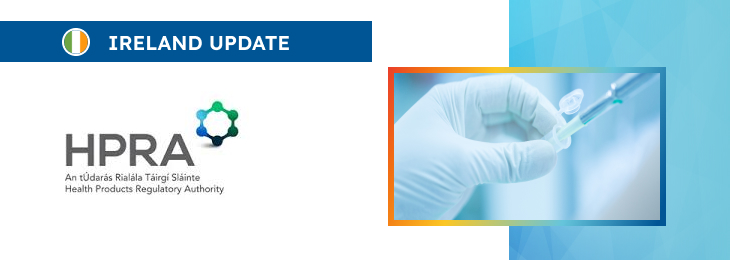The new article describes in detail the requirements in-house IVDs are subject to.

Table of content
The Health Products Regulatory Authority (HPRA), an Irish agency responsible for medical devices, has published a guidance document dedicated to the manufacture and use of in-house in vitro diagnostic medical devices (IVDs) by health institutions in Ireland. The document describes in detail the relevant regulatory requirements set forth under the existing legal framework and also provides additional clarifications and recommendations to be taken into consideration by medical device manufacturers and other parties involved in order to ensure compliance.
At the same time, the authority also reserves the right to make changes to the guidance and recommendations provided therein, should such changes be reasonably necessary to reflect corresponding amendments to the underlying legislation.
In particular, the authority has outlined specific requirements for health institutions in Ireland that manufacture and use in-house in vitro diagnostic medical devices (IVDs) to be followed in order to ensure continuous safety and proper performance of such products.
General Safety and Performance Requirements (GSPR)
First of all, the document describes the requirements set forth by the IVDR Annex I (Applicable 26 May 2022). All in-house IVDs must comply with the General Safety and Performance Requirements (GSPR) detailed in Annex I of the IVDR.
Health institutions must declare their compliance with these requirements as per IVDR Article 5(5)f. For ease, the requirements are presented in a checklist format in Appendix 1 of the guide, divided into three chapters:
- Chapter I (1-8): General requirements
- Chapter II (9-19): Requirements regarding performance, design, and manufacture
- Chapter III (20): Requirements regarding information supplied with the IVD
Another important set of requirements is established under Article 5(5) a-i, including:
- Article 5(5)a: Non-transferability (Applicable 26 May 2022): In-house IVDs must remain within the legal entity of the health institution that manufactures them and cannot be transferred to another entity. This does not restrict the transfer of specimens for testing or the issuance of results, even if specimens are referred from other health institutions or GPs for specialized testing.
- Article 5(5)b: Quality Management Systems (Applicable 26 May 2024): Health institutions must have an appropriate quality management system to meet the IVDR Article 5(5) and Annex I requirements. This system must oversee the manufacture and use of IVDs within the institution.
- Article 5(5)c: Compliance with EN ISO 15189 (Applicable 26 May 2024): Laboratories must comply with EN ISO 15189, either through accreditation or other means. If accredited, all in-house IVDs must adhere to the same processes. In the absence of accreditation, the institution must demonstrate compliance through documentation and internal audits. Existing legal requirements, such as those for hospital blood banks, remain unaffected.
- Article 5(5)d: Justification for Use (Applicable 26 May 2028): Health institutions must justify that the target patient group’s specific needs cannot be met by an equivalent CE-marked IVD. This justification can be based on performance comparisons, published literature, or concordance studies. The justification must be documented and periodically reviewed.
- Article 5(5)e: Information Provision (Applicable 26 May 2024): Health institutions must provide information on the manufacture and use of in-house IVDs to the HPRA upon request, including justifications for their use. They must notify the HPRA of their activities and report any serious incidents involving in-house IVDs.
- Article 5(5)f: Public Declaration (Applicable 26 May 2024): A public declaration must be made, including:
- The name and address of the manufacturing health institution.
- Details necessary to identify the devices.
- A declaration of compliance with the GSPR, or reasons for non-compliance.This declaration must be publicly accessible, such as on the institution’s website, and kept up to date.
- Article 5(5)g: Documentation for Class D Devices (Applicable 26 May 2024): For Class D IVDs, health institutions must maintain detailed documentation of the manufacturing facility, process, intended purpose, design, and performance. This documentation must be sufficient for the HPRA to verify compliance with the GSPR.
- Article 5(5)h: Manufacturing Compliance (Applicable 26 May 2024): For Class D IVDs, the manufacturing must align with the documented processes and facilities. Health institutions must ensure that all devices are manufactured as per the documentation.
- Article 5(5)i: Review and Corrective Actions (Applicable 26 May 2024): Health institutions must review the clinical use of in-house IVDs and take necessary corrective actions based on the findings. This includes documenting reviews, reporting serious incidents to the HPRA, and implementing corrective actions promptly.

Health Institution Notification
Under the general rule, all health institutions in Ireland that manufacture and use in-house IVDs must notify the HPRA of their activities. Detailed notification procedures will be provided on the HPRA website.
Incident Reporting
The document also pays special attention to the rules and requirements related to incident reporting. According to the guidance, incidents involving in-house IVDs must be recorded and serious incidents reported to the HPRA within specified timelines:
- Immediately and no later than 15 days after becoming aware of the incident
- Within two days for serious public health threats
- Within 10 days for incidents involving serious deterioration in health
Timeline for Compliance
It is also important to mention that different requirements of IVDR Article 5(5) apply at different times:
- From 26 May 2022: Initial requirements including non-transferability
- From 26 May 2024: Quality management systems, ISO 15189 compliance information provision, public declaration, Class D documentation, and manufacturing compliance
- From 26 May 2028: Justification for use
Conclusion
In summary, the present HPRA guidance provides an in-depth overview of the regulatory requirements in-house IVDs are subject to, highlighting the key points to be taken into consideration by healthcare institutions manufacturing and using such products. The document also explains the approach to be applied with respect to certain specific aspects, such as incident reporting or timelines for implementation for the said requirements.
How Can RegDesk Help?
RegDesk is a holistic Regulatory Information Management System that provides medical device and pharma companies with regulatory intelligence for over 120 markets worldwide. It can help you prepare and publish global applications, manage standards, run change assessments, and obtain real-time alerts on regulatory changes through a centralized platform. Global expansion has never been this simple.

